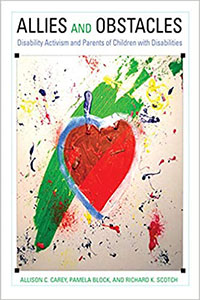News and Updates
Contact
Faculty of Social Science
Social Science Centre
Room 9438
Western University
T. 519-661-2053
F. 519-661-3868
E. social-science@uwo.ca
Allies and Obstacles examines how allies may be part of the problem
April 16, 2020
Story by Rob Rombouts
 Can allies be part of the problem?
Can allies be part of the problem?
A new book, co-authored by Pamela Block, Professor in the Department of Anthropology, examines this question in the realm of disability activism. Allies and Obstacles looks at the history of parent activism, comparing approaches of parents in different impairment groups.
The book is co-authored by Allison C. Carey, Professor in the Department of Sociology and Anthropology at Shippensburg University, and Richard K. Scotch, Professor of Sociology and Public Policy at the University of Texas, Dallas.
The co-authors all have long connection to the field of disability studies. Scotch is considered a foundational scholar in the area of disability studies. Along with their academic connection, Carey and Block have personal connections to the field as both have siblings with disabilities. This provided a deeper understanding of parental activism, both through the scholarship and what they witnessed in their lives.
Examining four different disability groups - autism, intellectual disability, psychiatric diagnoses, and physical disabilities - the authors consider the relationship between parental activism and activism led by people with disabilities, and how parents may engage differently with children with different disabilities.
Parents often position themselves at the forefront of the movements, in a role of parental advocacy Carey said, and this can be complicated. Sometimes they can be allies, but sometimes they can be on different sides of the position.
“Parents get involved looking for answers to their pressing needs. They want political solutions to address immediate needs at the time, and often look to other parents,” said Carey. “They don’t look to adults with disabilities, and don’t even necessarily know about activism led by people with disabilities.”
“For many disabled people in activist roles, they see parents as something they have to fight against, based on lived experience,” said Block, but disability activists and parents can both take time to understand the complexity of where the other group is coming from.
“For autism, parent activists are very focused on support and treatment for children,” said Block “Some of the things they are advocating for, autistic adults say are traumatizing.”
In the intellectual disability field, Carey points to the history of institutionalization and residential segregation. While disability activists and most parents have fought against large institutions, some parents remain supportive of institutional solutions. In terms of community-based supports, the solutions offered differ. In general, self-advocates fight for community-based homes, with individualized budgets. Parent advocates may prefer larger homes with more bureaucratic oversight, where they feel more specialized services can be provided. These divergent opinions highlight differing views of what make a good quality of life: having access to specialized services, or having the opportunity to live in and be integrated into the community.
The second half of the book provides a cross-disability analysis, looking at when parent activism arose, what policies groups advocate for, and why some parents are more involved with disability activism. Through this approach, the authors look at shared issues, such as communication access, and the role of disabled people to be able to speak for themselves as individuals as opposed to situations when their ability to communicate is questioned.
Along with these aspects, the authors also examine the difference between disability rights and disability justice, examining how rights may be harder to achieve for people from less-privileged groups.
“People with privilege can navigate the rights-based approaches, but this doesn’t necessarily hold true for people who are also discriminated against not just due to disability but also due to class, ethnic, racial, or immigration status, or other stigmatized categories,” said Block.
Scotch said the relationship between parent advocacy and disability activists has not been fully examined in the scholarship.
“We hope it will help people all around to understand what is going on,” said Scotch. “When you’re an advocate, you tend to think of it as a matter of goals, but there is complexity all around.”
Allies and Obstacles: Disability Activism and Parents of Children with Disabilities will be available on June 22 from Temple University Press.

